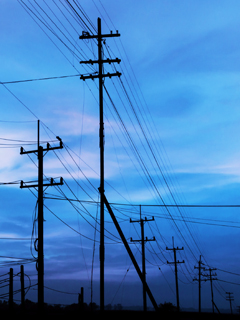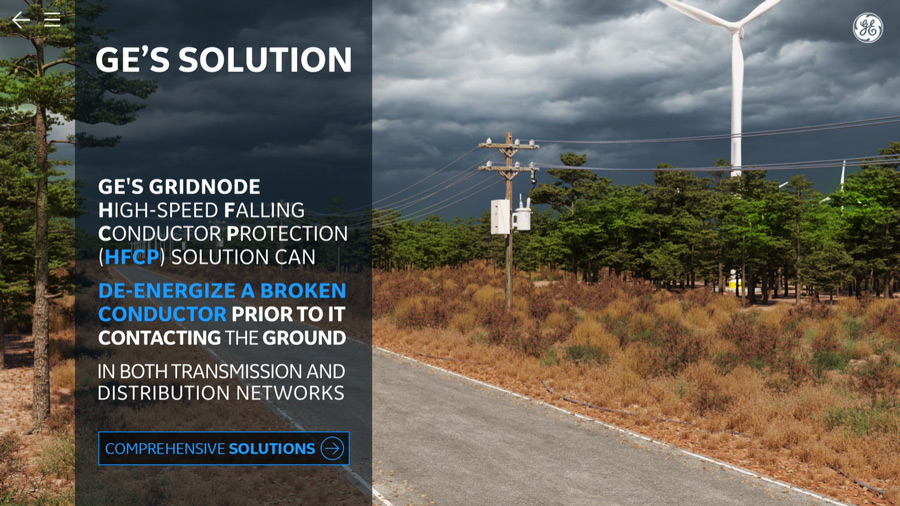GridNode High-Speed Falling Conductor Protection
GE Vernova’s GridNode High-Speed Falling Conductor Protection provides a reliable solution to detect and isolate broken overhead line conductors using secure wide-area measurements.
When an overhead power line breaks, the energized conductor falls to the ground or surrounding objects causing a high-impedance fault and/or arcing. For over 20 years, the industry has relied on negative-sequence current (I2/I1) principles to detect a broken conductor. However, with the increasing penetration of Distributed Energy Resources(DERs) and depending on the number of loads and/or presence of single-phase loads connected to a line, this solution is no longer an efficient method of protection.
GE Vernova’s GridNode High-Speed Falling Conductor Protection offers an evolution to falling conductor monitoring and protection by delivering enhanced reliability, speed, and performance needed for today’s distribution networks.
To learn more about GE Vernova’s GridNode High-Speed Falling Conductor Protection (HFCP), read our 2-part interview series as we answer important questions about the risks of broken conductors and the advantages of HFCP. We also explore HFCP system architecture and study the testing phases of this solution.
Key Benefits
- Reliably identify broken overhead lines and trip corresponding breakers or block a recloser under 500ms prior to the conductor touching the ground
- Easy deployment with no coordination required with existing protection settings
- Minimize customer impact with coordinated operation to isolate the broken line
- Increased flexibility through the ability to accommodate high DER penetration
- Prolong asset life by preventing potential damage caused by unnecessary reclosing
- Increased reliability with the capability to detect broken conductors in low load branches as well as feeder end
- Enhanced reliability through real-time adaptive settings
- Low implementation costs by leveraging existing digital protective relays
GridNode High-Speed Falling Conductor Protection
GE Vernova’s GridNode High-Speed Falling Conductor Protection provides a reliable solution to detect and isolate broken overhead line conductors using secure wide-area measurements.
When an overhead power line breaks, the energized conductor falls to the ground or surrounding objects causing a high-impedance fault and/or arcing. For over 20 years, the industry has relied on negative-sequence current (I2/I1) principles to detect a broken conductor. However, with the increasing penetration of Distributed Energy Resources(DERs) and depending on the number of loads and/or presence of single-phase loads connected to a line, this solution is no longer an efficient method of protection.
GE Vernova’s GridNode High-Speed Falling Conductor Protection offers an evolution to falling conductor monitoring and protection by delivering enhanced reliability, speed, and performance needed for today’s distribution networks.
To learn more about GE Vernova’s GridNode High-Speed Falling Conductor Protection (HFCP), read our 2-part interview series as we answer important questions about the risks of broken conductors and the advantages of HFCP. We also explore HFCP system architecture and study the testing phases of this solution.
Key Benefits
- Reliably identify broken overhead lines and trip corresponding breakers or block a recloser under 500ms prior to the conductor touching the ground
- Easy deployment with no coordination required with existing protection settings
- Minimize customer impact with coordinated operation to isolate the broken line
- Increased flexibility through the ability to accommodate high DER penetration
- Prolong asset life by preventing potential damage caused by unnecessary reclosing
- Increased reliability with the capability to detect broken conductors in low load branches as well as feeder end
- Enhanced reliability through real-time adaptive settings
- Low implementation costs by leveraging existing digital protective relays
GE Vernova’s GridNode High-Speed Falling Conductor Protection provides a reliable solution to detect and isolate broken overhead line conductors prior to the conductor touching the ground for both transmission and distribution networks. This is a substation centric based solution that is based on the rate of change of impedance.
Typical Broken Falling Conductors take 1.3 seconds to touch the ground on a distribution system.
Network Benefits
- Increased Safety through quick detection and isolation of broken overhead lines
- Risk Reduction in fire ignition caused by a down conductor
- Reduced damage caused by unnecessary network reclosing
- Increased customer reliability by minimizing the number of customers interrupted through coordinated protection
- Ability to accommodate a high and growing number of distributed energy resources on your network without impacting broken falling conductor protection

NORMAL STATE
Traditional Protection

BROKEN FALLING CONDUCTOR
GridNode High-Speed Falling Conductor Protection
Benefits
- Operates in under 500ms prior to the conductor touching the ground
- Up to 8 times better sensitivity at detecting broken conductors than conventional I2/I1 methods for distribution networks
- Works in areas with high penetration of DERs
- No coordination required with existing protection devices
- Scalable to multiple feeders and beyond the substation and has the ability to isolate and coordinate the trip to the faulted line section

BROKEN DOWN CONDUCTOR
Down Conductor Technology
Benefits
- Ability to detect down conductors under certain circumstances
Drawbacks
- Safety and fire concerns as conductor has already touched the ground
- Applicability depends on ground surface type
Architecture
GE Vernova’s GridNode High-Speed Falling Conductor Protection Solution is scalable system that provides reliable and fast detection of broken falling conductors in the distribution or transmission system. The solution can connect to devices inside the substation as well as along the feeder.
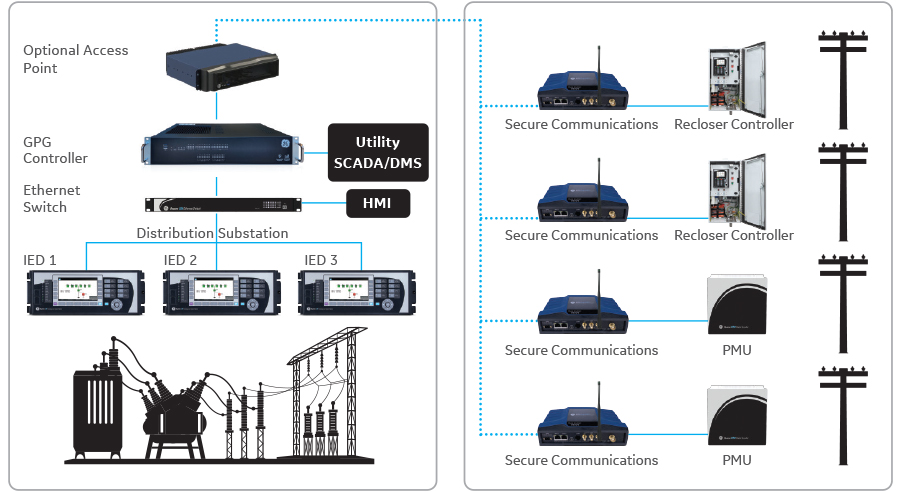
SUBSTATION BASED SOLUTION
- Increased detection capabilities on low load branches
- Ability to coordinate and sectionalize the line closest to the fault
- Requires V&I measurements from IEDs
- Supports up to 10 Feeders
- Vendor agnostic
- Utilizes standard communication protocols
SUBSTATION + LINE DEVICES SOLUTION
- Increased detection capabilities on low load branches
- Ability to coordinate and sectionalize the line closest to the fault
- Requires PMU data for connected IEDs
- Supports industrial standard communications (fiber optic, radio (licensed or unlicensed) or cellular
Services
GE Vernova’s Advanced Application Services team provides the following engineering and consulting services as part of the High-Speed Falling Conductor Protection solution.
| CONSULTING | PMU placement assessment and support Deployment strategy |
| COMMUNICATIONS | Network and communications system design Hardware specification |
| ENGINEERING | System configuration; Settings development Cybersecurity |
FACTORY TESTING | Factory acceptance testing including Hardware-in-the-Loop (HIL) testing and validation |
| INSTALLATION & SITE INTEGRATION | Field services; Site integration services Communications, network, and I/O testing |
TESTING & COMMISSIONING | Site acceptance testing and performance validation |
TRAINING & SUPPORT | Master service agreement to help maintain the accuracy of the operation following network topology changes |
Components
GE Vernova’s GridNode High-Speed Falling Conductor Protection Solution includes the following:

GPG Controller
GridNode High-Speed Falling Conductor Protection Solution - Hardware specifications
- Certification: IEC 61850-3, IEEE 1613, CE, FCC Class A, UL, CCC
- Mounting: 2U/19” Rack mount
- System Design: Fanless, with no internal cabling
- OS Support: Windows and Embedded RTOS VxWorks for critical real time
- Power Consumption: 19W/220VAC or VDC (Typical)
- Power Supply: Redundant 100 ~ 240 VAC (47 ~ 63 Hz) DC: 100 ~ 240 VDC DC: 48VDC with isolation protection
- PRP & HSR Ethernet redundancy
- Two expansion slots to increase serial and Ethernet port types and quantity
GridNode HFCP HMI
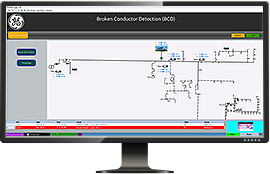
GridNode HFCP Configurator
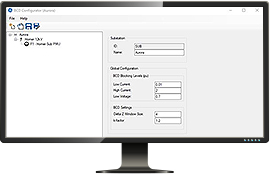
Solution Components
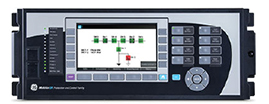 Protective Relays
Protective Relays

Communication Switches

Time synchronization clock
